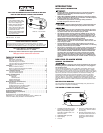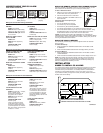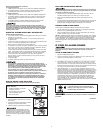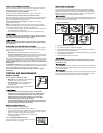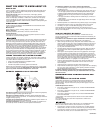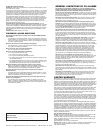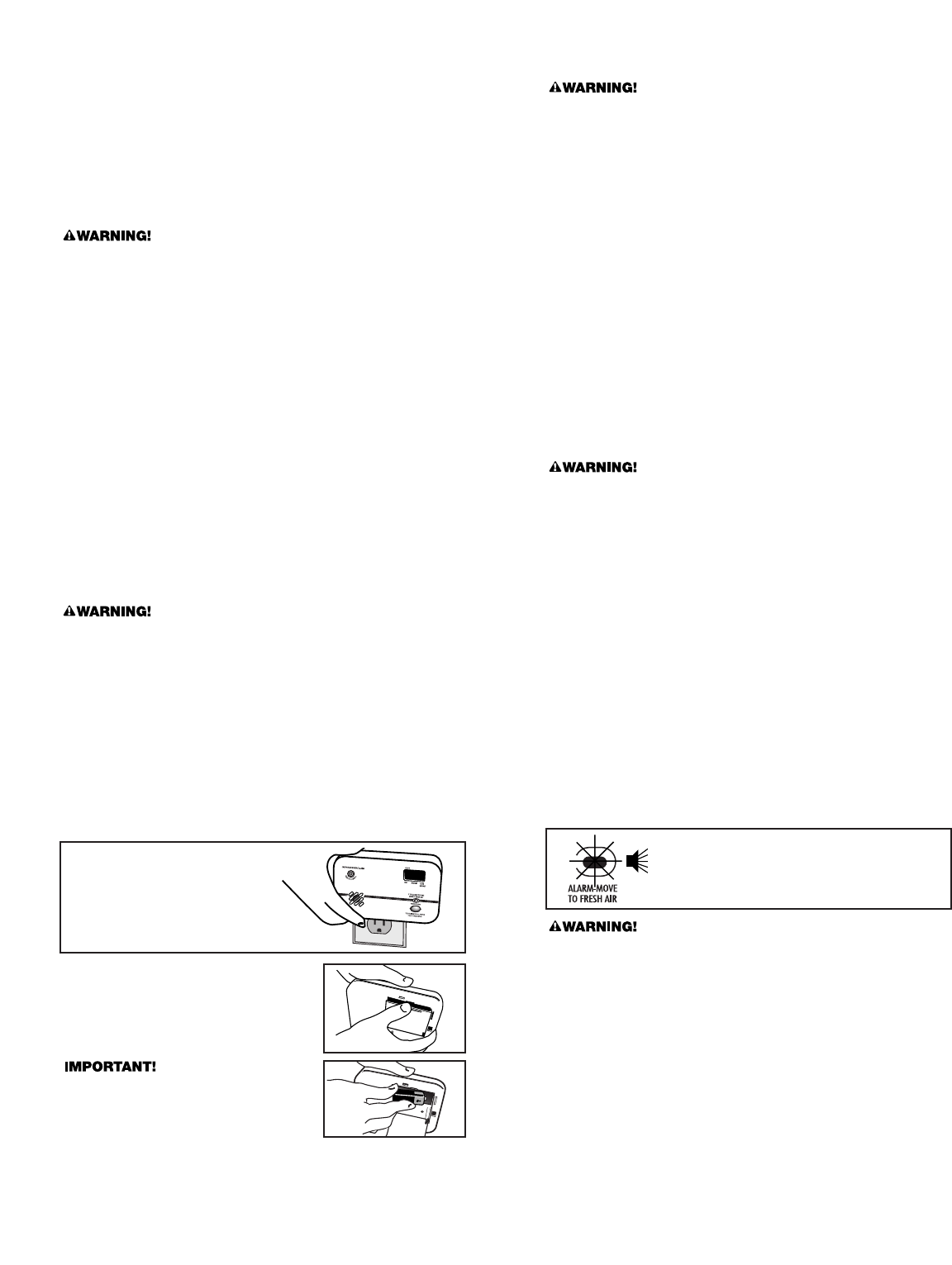
Where to Install CO Alarms, Continued
In a Single-level Home:
• Install at least one CO Alarm near or within each separate sleeping area.
• For added protection, install an additional CO Alarm at least 20 feet
(6 meters) away from the furnace or fuel burning heat source.
In a Multi-level Home:
• Install at least one CO Alarm near or within each separate sleeping area.
• For added protection, install at least one CO Alarm on each level of the
home. If you have a basement, install that CO Alarm at the top of the
basement stairs.
• For added protection, install an additional CO Alarm at least 20 feet
(6 meters) away from the furnace or fuel burning heat source.
This unit should receive continuous electrical power. (The battery is
meant for emergency back-up only). Choose an outlet where it can’t be
accidentally unplugged or switched off by children. Keep small children
away from the unit. Teach them not to play with it or unplug it. Explain
what the alarms mean.
WHERE CO ALARMS SHOULD NOT BE INSTALLED
DO NOT locate this CO Alarm:
• In a location where it could be easily triggered when using your remote to
operate your TV, VCR, etc.
• In garages, kitchens, furnace rooms, or in any extremely dusty, dirty
or greasy areas.
• Closer than 15 feet (4.6 meters) from a furnace or other fuel burning heat
source, or fuel burning appliances like a water heater.
• Within 5 feet (1.5 meters) of any cooking appliance.
• In extremely humid areas. This Alarm should be at least 10 feet (3 meters)
from a bath or shower, sauna, humidifier, vaporizer, dishwasher, laundry
room, utility room or other source of high humidity.
• In areas where temperature is colder than 40˚F (4˚C) or hotter than 100˚F
(38˚C). These areas include non-airconditioned crawl spaces, unfinished
attics, uninsulated or poorly insulated ceilings, porches, and garages.
• In turbulent air, like near ceiling fans, heat vents, air conditioners,
fresh air returns, or open windows. Blowing air may prevent CO from
reaching the sensors.
• In direct sunlight.
• In outlets covered by curtains or other obstruction.
• This CO Alarm is designed for use inside a single-family home or
apartment. It is not meant to be used in common lobbies, hallways, or
basements of multi-family buildings unless working CO Alarms are
also installed in each family living unit. CO Alarms in common areas
may not be heard from inside individual family living units.
• This CO Alarm alone is not a suitable substitute for complete
detection systems in places which house many people, like hotels or
dormitories, unless a CO Alarm is also placed in each unit.
• DO NOT use this CO Alarm in warehouses, industrial or commercial
buildings, special-purpose non-residential buildings, RVs, boats,
or airplanes. This CO Alarm is specifically designed for residential
use, and may not provide adequate protection in non-residential
applications.
3
PLUG THE ALARM INTO AN OUTLET
This CO Alarm should receive continuous electrical power. The battery is
meant for emergency back-up only. Do not plug this Alarm into an outlet
controlled by a dimmer or switch.
1. Plug the unit into a standard UNSWITCHED 120V AC outlet. The unit
should be located where it can wake you if it alarms at night.
2. Make sure the POWER/ALARM light shines continuously when you
plug it in.
3. Test by pressing the Test/Silence/Scroll button firmly until the unit sounds:
4 beeps, pause, 4 beeps. During testing, the POWER/ALARM light will
flash and “888” will appear briefly on the Display. This is normal.
PREPARE YOUR ALARM LABELS
Find the pair of self-adhesive labels included with this CO Alarm.
• On each label write in the phone number of your emergency responder
(like 911) and a qualified appliance technician.
• Place one label near the CO Alarm, and the other label in the “fresh air”
location you plan to go if the alarm sounds.
NOTE: A qualified appliance technician is defined as “a person, firm, corpora-
tion, or company that either in person or through a representative, is engaged
in and responsible for the installation, testing, servicing, or replacement of
heating, ventilation, air conditioning (HVAC) equipment, combustion appli-
ances and equipment, and/or gas fireplaces or other decorative combustion
equipment.”
HOW TO INSTALL YOUR CO ALARM
IMPORTANT! Read all instructions before using this product.
ACTIVATE THE BATTERY BACK-UP
1. Open the battery compartment on the back
of the Alarm.
2. Connect the battery to the battery contacts,
making sure it cannot shake loose.
3. Close the battery compartment completely.
The battery back-up is designed to provide
emergency power to the CO Alarm for 7 days.
Actual back-up time depends on the strength
(freshness) of the battery. The battery back-up
will not work unless a good battery is properly
installed.
Quick reference:
• Install the 9V battery to activate
the battery back-up.
• Plug the Alarm into a standard
120V unswitched outlet.
• Test the CO Alarm.
IF YOUR CO ALARM SOUNDS
Actuation of your CO Alarm indicates the presence of carbon monoxide
(CO) which can kill you. When your CO Alarm sounds, you must not
ignore it!
IF THE ALARM SIGNAL SOUNDS:
1. Operate the Test/Silence button.
2. Call your emergency services, fire department or 911. Write down the
number of your local emergency service here:
__________________________________________________________________
3. Immediately move to fresh air—outdoors or by an open door or window.
Do a head count to check that all persons are accounted for. Do not re-
enter the premises, or move away from the open door or window until the
emergency services responder has arrived, the premises have been aired
out, and your CO Alarm remains in its normal condition.
4. After following steps 1-3, if your CO Alarm reactivates within a 24-hour
period, repeat steps 1-3 and call a qualified appliance technician to inves-
tigate for sources of CO from fuel-burning equipment and appliances, and
inspect for proper operation of this equipment. If problems are identified
during this inspection have the equipment serviced immediately. Note any
combustion equipment not inspected by the technician, and consult the
manufacturers’ instructions, or contact the manufacturers directly, for
more information about CO safety and this equipment. Make sure that
motor vehicles are not, and have not, been operating in an attached
garage or adjacent to the residence. Write down the number of a qualified
appliance technician here:
_________________________________________________________________
Alarms have various limitations. See "General Limitations of CO Alarms"
for details.
Continued...
“ALARM-MOVE TO FRESH AIR”
If you hear the alarm horn and the red light is
flashing, move everyone to a source of fresh air.
DO NOT unplug the CO Alarm!



